Pictures are mostly 1600x1200 pixels / ca. 350 KB.
Standard keyboard (type 1a, issue 1 PCB), precursor to the standard type 1 keyboard:
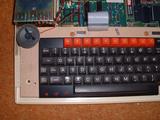
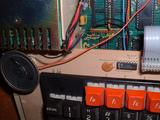
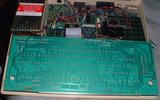
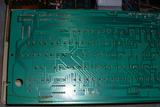
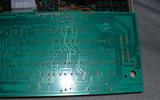
Note the area near the speaker and compare to the later version.
Weight ca. 640 g.
Standard keyboard (type 1, issue 1 PCB), top and solder side:
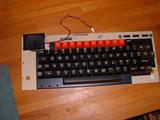

Used on issue 1,2,3,4,7 BBCs.
Weight ca. 645 g.
Faint 'uop' (the keyboard maker I presume) embedded in the glassfibre of the PCB
Apparently came with 2 types of speaker grille, the earlier one is pictured on the right, and has a thicker plastic top (from the machine with serial no. AB 154863, with the old, rough surface case). The grille on the left is used on later type 1 keyboards, like the machine with serial no. AB 166873 which has the same early case type as AB 154863:

Standard keyboard (type 1, issue 1 PCB), but OAK logo embedded in the glassfibre of the PCB, which is very smooth and nearly white.
Weight ? g.
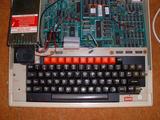
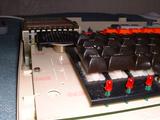
Later keyboard (type 4, issue 1 PCB), top and solder side:




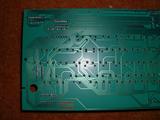
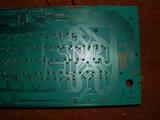
Probably used only on issue 7 BBCs.
Weight ca. 595 g.
Later keyboard (type 2, issue 2 PCB), top and solder side:
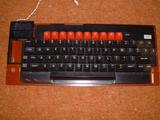
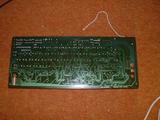
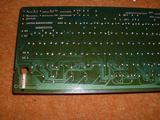
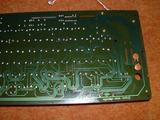
Probably used only on issue 7 BBCs. The keyboard PCB is made of pertinax; a step back in quality from the glassfibre on type 1/4. The mounting plate is from steel (instead of aluminium in type 1 & 4)
Weight ca. 935 g.
Later keyboard (type 2a, issue 2 PCB), top and solder side:
Pictures to be added


Probably used only on issue 7 BBCs. Note the keyboard PCB is made of pertinax; a step back in quality from the glassfibre on type 1/4. The mounting plate is from steel (instead of aluminium in type 1 & 4)
Weight ca. 935 g. Only slightly different from type 2 (few holes and bolts).
Later keyboard (type 3, issue 2 PCB), top and solder side:

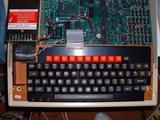
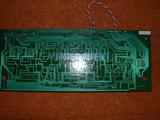
Probably used only on issue 7 BBCs. Note the keyboard PCB is made of pertinax; a step back in quality from the glassfibre on type 1/4. The mounting plate is from aluminium.
Weight ca. 670 g.
US BBC keyboard (type 5, issue ?? PCB), to be filled in...
Type 1: the standard keyboard for the early machines up to mid 1984 (later too? if so with issue 2 pcb?). Aluminium mounting plate, glassfibre PCB, probably all issue 1 (with speech socket wiring error). Switches have such a shape that spilled fluids don't easily get into the keyswitch. Bad point is the space bar stabilizer: You can't get it out to bend it a little if it's not perfectly straight, which it almost never is on this keyboard. The result is that almost all type 1 keyboards have a fairly heavy going and/or slightly sloping (from left to right) spacebar. This is bad for e.g. planetoid... Most reliable keyboard, the best general purpose keyboard.
Type 1a, precursor to the standard type 1 keyboard. In the later type 1 keyboard, a chunk of the metal plate is removed and the PCB layout has been rearranged a little, esp. moving the resistors, to make way for the speaker grille. Other than that, same as the standard type 1.
Type 4: The keyboard seemingly following type 1: Aluminium mounting plate, glassfibre PCB, keyswitch shape is less good than type 1, fluids more easily get into the switch. PCB slightly updated, but still issue 1 (no issue no printed on the PCB, but the speech wiring mistake is present; I haven't checked exactly what has changed). Space bar stabilizer easy to get to. Maybe the best typing keyboard, depending on ones taste.
Type 2: Probably from mid 1984 on: Steel mounting plate, pertinax PCB (both are downgrades from the aluminium/glassfibre and these together with the heavier keytops make the keyboard a LOT heavier than a type 1 or 4), keyswitch shape same as type 4 but the shaft is bent, so symmetrical keys can be used, PCB is issue 2 (it doesn't say so on the PCB, but the speech wiring mistake is gone), Space bar stabilizer as on type 4. Keytops are smaller than on the other types. Types heavier than the others. This looks very much a money saving (for Acorn, not the buyers!) keyboard. Types nicely for text, but for action games it's not really suited.
Btw. It's possible to fix heavy/sticking keys (that's what you get with this keyboard!) using 'wasbenzine' (dutch name, is that 'white spirit' in english?) and/or breathing onto the shaft of the key to be handled (to get it damp so junk gets loose) and moving it up down (preferably keeping the keyboard upside down so any residu comes out of the switch!). May take quite a bit of work, but I've been able to make the keys work almost as new this way.
Type 2a: Almost the same as type 2. Not sure which was first (probably type 2, as 2a has some extra bolts).
Type 3: Probably from mid 1984 on: Aluminium mounting plate, pertinax PCB (a downgrade from the glassfibre of type 1 and 4), keyswitch shape is good, no fluids will get into here unless you tip it over at extreme angles while spilling tea on it :), PCB is issue 2, Space bar stabilizer is absent and not needed. Types easier than 2, but heavier than 1,4. This has a bit of a toy feel... As with type 2 this looks very much a money saving (for Acorn) keyboard. Again this keyboard is less suited to playing action games than types 1 and 4. I don't like this keyboard!
Type 5: Used on the USA version of the BBC. Variant of type 1. To be filled in...
Other types that are known to exist: russian keyboard (the keytops have russian symbols, variant of type 2)
























